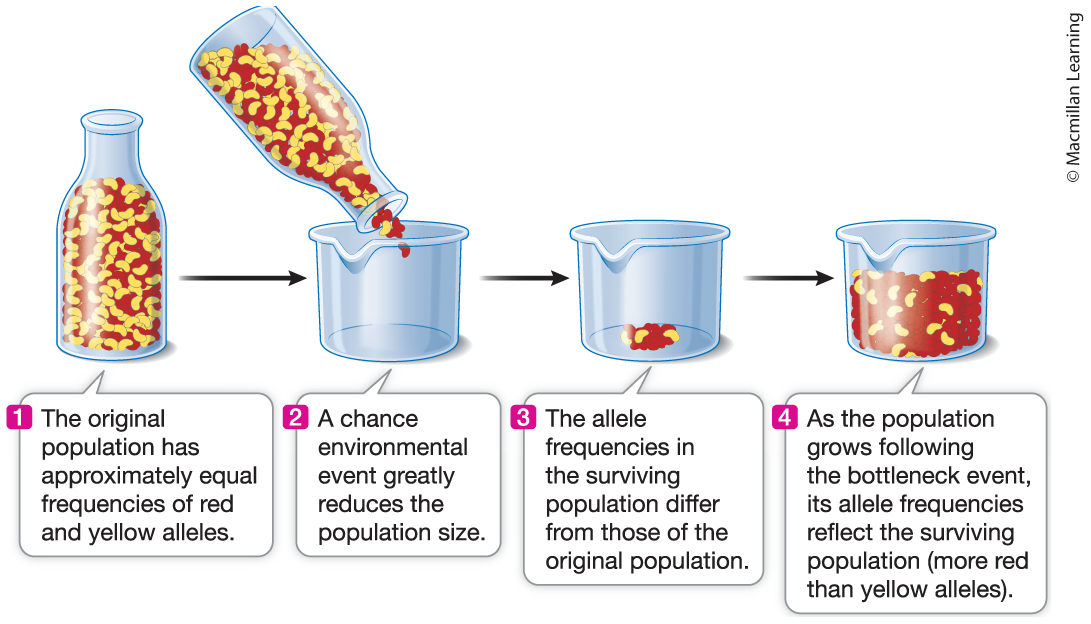Principles of Life, Ch. 13 Reading
13.1 Evolution is Both Factual and the Basis of Broader Theory
- Evolution: Any gradual change. Most often refers to organic or Darwinian evolution, which is the genetic and resulting phenotypic change in populations of organisms from generation to generation.
- Evolutionary Theory: The understanding and application of the mechanisms of evolutionary change to biological problems.
- Darwin’s Theory
- Species are not immutable; they change over time.
- Descent with Modification: Darwin’s premise that all species share a common ancestor and have diverged from one another gradually over time.
- Natural Selection: The differential contribution of offspring to the next generation by various genetic types belonging to the same population. The mechanism of evolution proposed by Charles Darwin.
- Darwin realized that many more individuals of most species are born than survive to reproduce.
- Artificial Selection: Selective breeding of organisms, commonly practiced by animal and plant breeders, to increase the frequency of a favored trait from one generation to the next.
- Alfred Russel Wallace also proposed natural selection at the same time
13.2 Mutation, Selection, Gene Flow, Genetic Drift, and Nonrandom Mating Result in Evolution
Population: In ecology, a group of individuals of the same species that live, interact, and reproduce together in a particular geographic area.
Individuals do NOT evolve.
The origin of genetic variation is mutation.
Alleles: A specific form of a gene at a given locus on a chromosome, among multiple possible forms.
Gene Pool: All of the different alleles of all of the genes existing in all individuals of a population.
Allele Frequency: The proportion of each allele in a gene pool.
Genotype Frequency: The proportion of each genotype among individuals in a population.
Adaptation: In evolutionary biology, a particular structure, physiological process, or behavior that makes an organism better able to survive and reproduce. Also, the evolutionary process that leads to the development or persistence of such a trait.
Biologists regard an organism as being adapted to a particular environment when they can demonstrate that a slightly different organism reproduces and survives less well in that environment
Gene Flow: Exchange of genes between populations through migration of individuals or movements of gametes.
Genetic Drift: Changes in gene frequencies from generation to generation as a result of random (chance) processes.
Population Bottleneck: A period during which only a few individuals of a normally large population survive.

Founder effect: Random changes in allele frequencies resulting from establishment of a population by a very small number of individuals.
Sexual Selection: Selection by one sex of characteristics in individuals of the opposite sex. Also, the favoring of characteristics in one sex as a result of competition among individuals of that sex for mates.
13.3 Evolution Can Be Measured by Changes in Allele Frequencies
- Genetic Structure: The frequencies of the different alleles at each locus and the frequencies of the different genotypes in a population.
- Hardy-Weinberg Equilibrium: The expected frequencies of alleles and genotypes in a population under random mating, in the absence of natural selection, mutation, migration, and genetic drift.
- Hardy-Weinberg only applies to sexually reproducing organisms.
- Conditions for Hardy-Weinberg equlibrium:
- There is no mutation
- There is no selection among genotypes
- There is no gene flow
- Population size is infinite
- Mating is random
- Populations in nature never meet the conditions for Hardy–Weinberg equilibrium, which is why we can say all biological populations evolve.
13.4 Selection Can be Stabilizing, Directional, or Disruptive
Fitness: An individual’s contribution of genes to the next generation, as a consequence of its success in surviving and reproducing.
Fitness of a phenotype is determined by the relative rates of survival and reproduction of individuals with that phenotype.
Stabilizing Selection: Selection against the extreme phenotypes in a population, so that the intermediate types are favored.
Directional Selection: Selection in which phenotypes at one extreme of the population distribution are favored.
Disruptive Selection: Selection in which phenotypes at both extremes of the population distribution are favored.

Purifying Selection: The elimination by natural selection of detrimental characters from a population.
Positive Selection: Natural selection that acts to establish a trait that enhances survival in a population.
When disruptive selection operates, individuals at opposite extremes of a character distribution contribute more offspring to the next generation than do individuals close to the mean, which increases variation in the population
13.5 Selection Can Maintain Polymorphisms in Populations
- Frequency-Dependent Selection: Selection that changes in intensity with the proportion of individuals in a population having the trait.
- Genetic variation within species is maintained in geographically distinct populations
- Clinal Variation: Gradual change in the phenotype of a species over a geographic gradient.